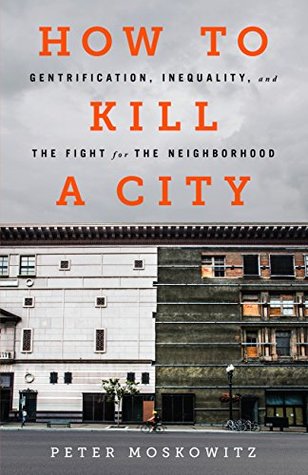More on this book
Community
Kindle Notes & Highlights
Read between
July 16 - August 1, 2017
Gentrification, at its deepest level, is really about reorienting the purpose of cities away from being spaces that provide for the poor and middle classes and toward being spaces that generate capital for the rich.
Bigard’s current financial problems—are not an accident but the predictable effects of turning cities into spaces that benefit no one but those who control capital.
you can usually trace the start of that change not to a few pioneering citysteaders but to a combination of federal, local, and state policies that favor the creation of wealth over the creation
of community.
Before Katrina, the Lower Ninth was nearly 100 percent black, and despite its reputation as being a poor section of the city, it was actually mostly middle-income—the median area income at the 2000 census was $37,894. The area had one of the highest rates of African American homeownership in the country.
booms as the storm encroached, and rumors flew over whether the levees holding back the Industrial Canal had been deliberately blown in order to save richer areas of the city. Journalists and politicians derided the theories as paranoid, but African Americans had good reason to believe that the government would destroy one predominantly black area to save predominantly white ones.
it’s important to understand that the city has nearly always been actively hostile toward its black population. In 1927, the Mississippi River flooded, and Louisiana flood control officials decided their best option to minimize damage was to purposely breach a levee in Jefferson Parish, a rural section of Louisiana right next to New Orleans, in order to prevent New Orleans from flooding.
Stage four is when a neighborhood is already gentrified and begins to become even more wealthy. Managerial-class professionals replace the artists and punks. Properties that were held vacant by developers are turned into high-cost condos.
As Jane Jacobs wrote in The Death and Life of Great American Cities, “Private investment shapes cities, but social ideas (and laws) shape private investment. First comes the image of what we want, then the machinery is adapted to turn out that image.”
Florida proposed that cities revitalize themselves by attracting the “creative class,” an amorphous category of workers Florida created to describe essentially any profession in which someone relies on a modicum of creativity to do his or her job—doctors, lawyers, artists, movie producers, accountants, hair salon owners, “high end sales” people (a category including cashiers, managers, door-to-door salespeople, real estate brokers, and models), and so on.
they forget that Jane Jacobs, the other most famous urbanist in America, talked not only about what makes city blocks cute and community-oriented but also about all the ways in which governments encourage the destruction of places for the middle class.
“The white people left,” Mongo told me, sitting on one of the diner-style stools at his bar. “Then it got so bad the homeless left, then it got so bad the pigeons left. Then it was only me.”
He told me he was calling the celebration “Pollinator Night.” To Mongo, the term pollinator describes what gentrification has become in Detroit: the white kids move into a neighborhood, and investment and attention follow. Mongo said all the kids from Quicken, Rock Ventures, and the rest of the companies moving downtown are great for D’Mongo’s Speakeasy, but he can’t help but think it’s troubling that the city seems on its way back up only now that they’ve arrived.
“The city doesn’t really see black life as life,”
“When the pollinators come, that’s when the civilization comes.… It makes me angry, but you know some...
This highlight has been truncated due to consecutive passage length restrictions.
In their book American Apartheid, sociologists Douglas Massey and Nancy Denton provide clear evidence that American cities maintained or expanded housing segregation even as people of color gained civil rights and wealth and moved into northern cities in
greater numbers from rural areas in the South.
The effect of decades of segregation is that black Americans are poorer and less likely to achieve success than whites. In Stuck in Place, a study of the apartheid-like conditions of black America, New York University sociologist Patrick Sharkey found that over the last half century there has been virtually no improvement in the income of African Americans. While white children today who come from middle-class families can expect to earn on average $74,000, $20,000 more than their parents, black children can expect to earn $45,000 a year—not only significantly less than white kids, but $9,000
...more
reason: “When white families advance in economic status, they are able to translate this economic advantage into spatial advantage by buying into communities that provide quality schools and healthy environments for children.” This simply is not possible for most black families.
rush hour now starts at 5:00 a.m. This is what happens when you create an urban economy that people cannot afford to live in.
My childhood home was just a few blocks from where Jane Jacobs wrote The Death and Life of Great American Cities. And
David Wojnarowicz had sex with countless men and wrote about them all in one of the books I relied on most during my coming-out journey, Close to the Knives.


